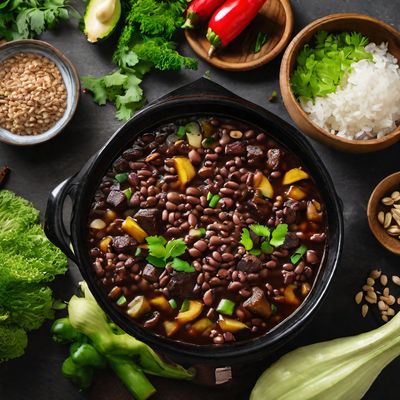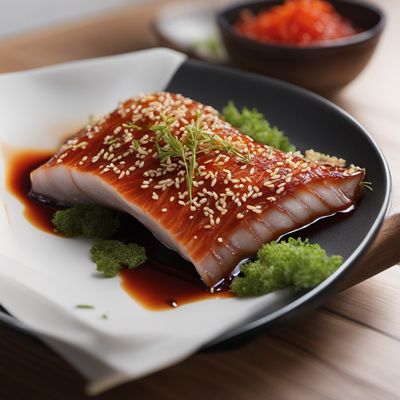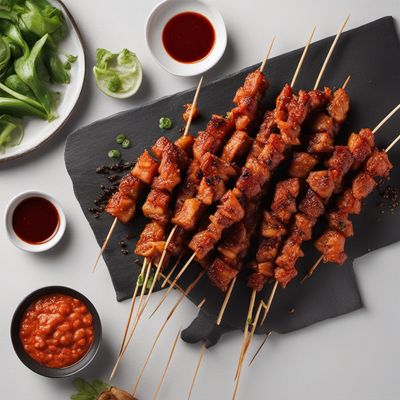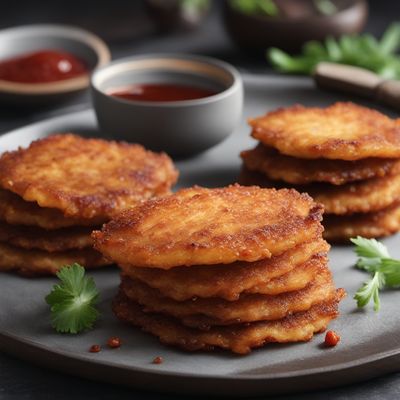
Recipe
Baechu-kimchi with a Twist
Spicy and Tangy Korean Baechu-kimchi Infused with Unique Flavors
4.8 out of 5
Baechu-kimchi is a traditional Korean dish that is loved for its spicy and tangy flavors. This recipe adds a twist to the classic by incorporating unique ingredients and flavors, resulting in a truly unforgettable culinary experience.
Metadata
Preparation time
30 minutes
Cooking time
N/A
Total time
2 days 30 minutes
Yields
4 servings
Preparation difficulty
Medium
Suitable for
Vegetarian, Vegan, Gluten-free, Dairy-free, Low calorie
Allergens
Fish (fish sauce)
Not suitable for
Nut-free, Soy-free, Paleo, Keto, Low-carb
Ingredients
-
1 large Napa cabbage (about 2 pounds / 900g) 1 large Napa cabbage (about 2 pounds / 900g)
-
1/4 cup (60ml) sea salt 1/4 cup (60ml) sea salt
-
1 tablespoon (15ml) fish sauce 1 tablespoon (15ml) fish sauce
-
2 tablespoons (30g) Korean chili flakes (gochugaru) 2 tablespoons (30g) Korean chili flakes (gochugaru)
-
4 cloves garlic, minced 4 cloves garlic, minced
-
1 tablespoon (15g) grated ginger 1 tablespoon (15g) grated ginger
-
1 small pear, grated 1 small pear, grated
-
1 small apple, grated 1 small apple, grated
-
1 small daikon radish, julienned 1 small daikon radish, julienned
-
2 green onions, chopped 2 green onions, chopped
-
1 tablespoon (15ml) soy sauce 1 tablespoon (15ml) soy sauce
-
1 tablespoon (15ml) rice vinegar 1 tablespoon (15ml) rice vinegar
-
1 teaspoon (5g) sugar 1 teaspoon (5g) sugar
Nutrition
- Calories (kcal / KJ): 45 kcal / 188 KJ
- Fat (total, saturated): 0.3g, 0g
- Carbohydrates (total, sugars): 10g, 6g
- Protein: 2g
- Fiber: 3g
- Salt: 2.5g
Preparation
-
1.Cut the Napa cabbage into quarters and remove the core. Chop the cabbage into bite-sized pieces.
-
2.In a large bowl, dissolve the sea salt in water. Add the cabbage and let it sit for 2 hours, turning occasionally.
-
3.Rinse the cabbage thoroughly under cold water and drain well.
-
4.In a separate bowl, combine the fish sauce, Korean chili flakes, minced garlic, grated ginger, grated pear, grated apple, julienned daikon radish, chopped green onions, soy sauce, rice vinegar, and sugar. Mix well to create a paste.
-
5.Using gloves, massage the paste onto the cabbage, ensuring each piece is coated evenly.
-
6.Transfer the kimchi into a clean glass jar, pressing it down firmly to remove any air bubbles.
-
7.Leave the jar at room temperature for 2-3 days to allow fermentation. After that, refrigerate for at least a week before consuming to enhance the flavors.
Treat your ingredients with care...
- Napa cabbage — Make sure to remove the tough outer leaves and rinse the cabbage thoroughly to remove any dirt or impurities.
- Korean chili flakes (gochugaru) — Adjust the amount according to your desired level of spiciness. You can also substitute with regular chili flakes if gochugaru is not available.
- Fish sauce — Look for a high-quality fish sauce to enhance the umami flavor of the kimchi.
- Daikon radish — Julienne the radish into thin strips for a pleasant crunch in the kimchi.
- Soy sauce — Use a low-sodium soy sauce if you prefer a less salty kimchi.
Tips & Tricks
- Use gloves when massaging the paste onto the cabbage to avoid staining your hands with the chili flakes.
- Allow the kimchi to ferment at room temperature for a couple of days before refrigerating to develop its flavors.
- The longer the kimchi is refrigerated, the more intense its flavors will become.
- Serve the kimchi as a side dish to complement rice, noodles, or grilled meats.
- Experiment with different vegetables and spices to create your own unique variations of kimchi.
Serving advice
Serve the Baechu-kimchi as a side dish alongside your favorite Korean main course. It pairs well with steamed rice, grilled meats, or even in a traditional Korean bibimbap.
Presentation advice
Present the Baechu-kimchi in a beautiful ceramic dish, showcasing its vibrant red color. Garnish with chopped green onions or sesame seeds for an added visual appeal.
More recipes...
For Baechu-kimchi
For Korean cuisine » Browse all

Korean-style Feijoada
Bibimbap-inspired Feijoada: A Fusion of Brazilian and Korean Flavors

Grilled Fermented Skate (Hongeo) with Spicy Soy Sauce
Fiery Delight: Grilled Fermented Skate with a Spicy Soy Twist

Bossam - Korean Braised Pork Belly Wraps
Savory Delight: Korean Bossam - Tender Braised Pork Belly Wraps
More Korean cuisine dishes » Browse all

Nabak kimchi
Nabak kimchi is a traditional Korean side dish made with sliced radishes. It is a refreshing and slightly sweet dish that is often served with...

Chamchi gimbap
Tuna gimbap
Chamchi gimbap is a type of Korean sushi that is filled with tuna. It is a popular snack that is easy to eat on the go.

Kkaennip-jeon
Kkaennip-jeon is a Korean dish made from perilla leaves that are coated in a batter and then pan-fried. It is a popular appetizer or side dish and...



